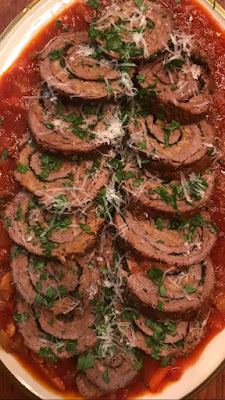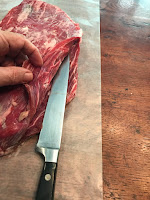Creamy crabmeat and artichoke salad served in an artichoke
pirogue beached upon a light tossed salad, as cool and refreshing as the
champagne on ice beside it.
When you feel like getting carried away, a pirogue is the
perfect means of transportation.
Here’s what you’ll need:
3 artichokes, of the pointy variety
3 lemons
1/2 lb lump crabmeat
1 stalk of celery, minced
1 scallion, finely sliced, with
a lot of green
1/2 C mayonnaise
1/4 C sour cream
1 t minced tarragon
hot sauce
black pepper
peppercorns
bay leaves
olive oil
The Pirogues
Put a stock pot filled with enough water to cover the
artichokes over high heat. Stir into the water about a 1/4 cup of good olive
oil; a handful of peppercorns; a couple of garlic cloves sliced in half; the
juice and carcasses of two lemons; and a bay leaf.
Of the three artichokes, take the two most boat like, and
trim them: with a pair of scissors, starting at the bottom, clip the thorny tip
of each leaf until you work you way up to the point. Do not touch the leaves
that comprise the point of the artichoke. It is the bow of your boat, and
should be left intact. These two artichokes will be cooked, then sliced in half
- forming four pirogues. But that’s later.
The third artichoke has a different purpose, so don’t worry
about trimming it.
When the water is boiling, throw in all three artichokes,
cover, and, on low-medium heat, cook 30 minutes. When they are done, remove,
drain and allow to cool.
With a sharp knife, remove the stems, and set aside.
Take the untrimmed artichoke, and slice off the point -
about 2-3 inches down from the tip. Now remove all the leaves. Since it is
cooked, you can do much of this with your fingers. Nestled in the center of
things, you will see the choke, prickly and disagreeable. With a paring knife,
or a grapefruit spoon, or both, carefully scoop out the choke, leaving
something like a basin. Whittle away the rough hide around it, and you will
have something resembling a hockey puck with a dip in the top. Something you would
put under a table leg to protect the floor.
In the canned goods world, this is what is called an “artichoke
bottom.” But it is really the artichoke heart - that is, the heart of the
honest-to-God-artichoke. I have to be careful here, because in the canned goods
world, what is called an “artichoke heart” is not that at all. It is basically
a “baby artichoke,” but do not suppose that to be an infant artichoke. Oh, no,
it is a fully matured artichoke whose growth was stunted because denied the sun by the h-t-G artichoke above it on the stalk. Having no choke, it is wholly edible, and should therefore be forgiven for all
the confusion it causes. Whew.
There is a parable in all that, somewhere. One day we will find it in a country song.
There is a parable in all that, somewhere. One day we will find it in a country song.
Now the two remaining artichokes are ready to become pirogues. With a large, sharp knife carefully slice them in half lengthwise. With a smaller sharp knife, trace a line - giving yourself an outside margin of at least 1/8 inch - around the choke, then cut along that line more and more deeply until you can remove the choke with your fingers. Remove the inner leaves, which are inedible - if you are unsure, take a bite and decide for yourself. But you want enough room for about a half cup of crab salad. More detail about all this, along with some photographs, can be found at Artichoke Pirogues With Crawfish Cardinale
Now peel the stems, cutting away all but the tender
(comparatively, anyway) flesh. Throw them in with the heart and dice it all up,
quarter inch. This will assist in turning what would otherwise be Crabmeat Mandeville into Artichoke Mandeville.
The Crabmeat Salad
In a mixing bowl, blend the celery, green onion, mayonnaise,
sour cream, tarragon, a few dashes of your favorite hot sauce, and black pepper
to taste. Cut the remaining lemon in half lengthwise. Set one half aside and
zest the other. Squeeze the juice of the zested lemon into the crab mixture,
and stir in the zest. Fold in the crabmeat, not in any heavy handed way, along
with the diced artichoke meat.
Thinly slice the remaining half lemon into so many half
moons. Pick the nicest four for garnish.
Now you have four pirogues. Fill them with the crabmeat
salad, dividing it evenly. Lend a becoming blush with a sprinkle of cayenne or
paprika. Garnish with the lemon slices.
Chill.
Serve atop a green salad, tossed with a light dressing, the
simpler perhaps the better, the remaining lemon slices thrown in.
























